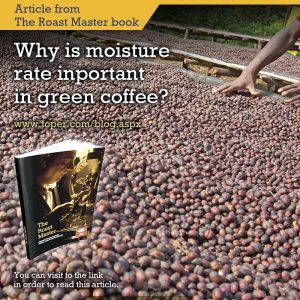The moisture rate of green coffee plays an important role on coffee quality. It will impact on the taste, quality of roast and profits of the farmer.
Coffee beans should contain roughly 45-55% moisture after pick-up process. Processing and drying processes will then reduce moisture content by up to 10-12%. Good moisture content allows the formation of a good aroma, good cupping notes and balanced acidity. According to the international coffee organization the moisture content of green coffee should be between 10-12%. During the transport of green coffee moisture may be lost due to some climatic conditions and changes.
QUALITY CONTROL IN DRYING PHASE
Coffee cherries tend to ripen irregularly. Therefore, most of the crops are inspected at multiple points during harvest and coffees are picked only ripened in 3rd generations farms.
It’s important that farmers do not mix beans that have different moisture rates. Otherwise these beans will cause inconsistent roasting. As a result consumers will not buy this coffee again.
There are several ways to dry coffee such as mechanical dryers, patios, tarpaulin, raised beds… In the good climate, raised beds will allow for airflow around the coffee. In turn, this can help to avoid fermentation and prevent mould.
While raised beds are generally preferred, patios can offer an advantage in lower temperatures. This is because heat from the ground will also help the coffee to dry. Raking and agitating becomes even more important on patios because there is no airflow.
EFFECTS OF LESS DRYING
Only green coffees with a moisture content of %12.5 or less can be traded. With coffee being traded in weight, moisture plays a sensitive role in how much money can be made from one sack.
Any breach of this standard greatly affect the supplier’s sales in the future. A broker who thinks that the moisture content of the product is too high can break the ties with the planting area. Hygiene is also very important. Fungus and mold can be formed when there is too much moisture. These defects can affect all roasting process. A supposedly premium AA-grade Arabica could come at an expensive price, only to taste foul due to under-drying. Clean and efficient storage of coffee should reduce the risk of mould. For the complete removal the beans are supposed be dried properly.
EFFECTS OF EXTRA DRYING
Like with under-drying, over-drying can have profound effects on cost. The farmers will have to pack more beans into each sack in order to make up for the loss in weight. Therefore, in larger plantations, the farmer may lose an entire sack’s worth of coffee from poor drying methods. As moisture can be lost during transit, farmers may over-pack the sacks anyway. This is both a courteous gesture and done to help procure the sale of more sacks in the future.
Over-drying also affects the quality and taste of coffee. At 9% moisture, you can expect a loss in aroma, freshness, and clarity. If the moisture content drops below 8%, then the roasted bean would contain hardly any flavour at all. As we said above, coffee below 8% should not be shipped.
Moisture content is also crucial when the coffee is being roasted. Since water conducts heat, the moisture in the bean provides a pathway for the heat transfer to the centre of the bean. With too little moisture, the beans roast too quickly on the outside and the inner is left raw – creating grassy flavours.





